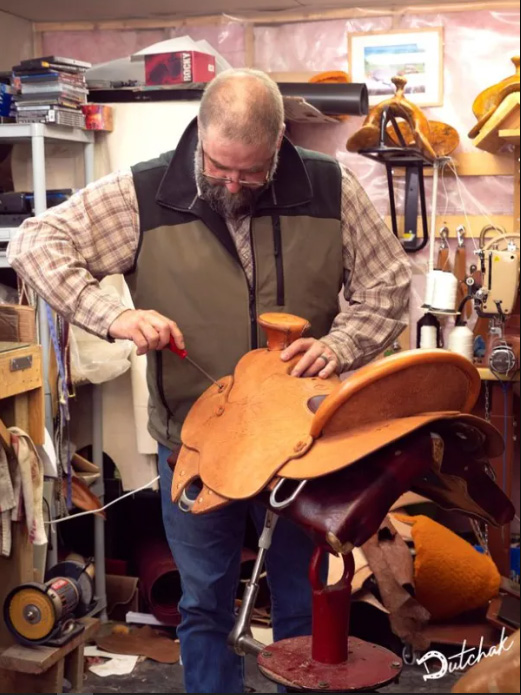
by Nick Pernokas
The sweeping Alberta plains epitomize the West. As you travel the lonely roads east of the Rockies in this vast country, you feel that you could be in the background of a Charlie Russell painting. You wonder about the people who settled this beautiful country. You might stop in a little town south of Calgary to stretch your legs or get some gas. If that town is High River, you could meet a man whose great grandparents were very important to the taming of this soil.
In 1900, Steve Mason’s great grandfather, Levi Bradley, and his brother opened Bradley’s Harness Shop in High River, Alberta. A majority of their work was harness, but they also made saddles. Eventually his son, Lou Bradley, took over the business. When Steve Mason was in high school, his grandfather, Lou, gave him some leather stamping tools and he began to do some leatherwork. When Steve was 16, he wanted to learn more about leatherwork, so he sought out Matt Eberle, another saddle maker in High River. Unfortunately, the mentorship didn’t work out at the time.
“I was just sort of a dumb kid. He thought I knew something and I didn’t know anything,” recalls Steve.
When Steve got out of high school, he started cowboying, something that he’d always enjoyed. In 1989, his grandfather invited him to ride down to Sheridan, Wyoming, with him. Lou was going to King’s Saddlery to get some ropes for his store, Bradley’s Western Store and Saddlery. Steve told Don King and John King about his interest in leatherwork, and they invited him to go to work for them. For the next six months, Steve worked in the King’s repair shop. That was followed by six months of working downstairs in the saddle shop with John King.
After his apprenticeship with King’s, Steve returned to High River and went to work at his grandfather’s shop. A couple of years later, Matt Eberle came in the shop and looked at one of the saddles that Steve had built.
“He came upstairs and said, “Hey kid, I think you’re ready to learn something. Be at my shop at five.”
Matt ended up becoming a great friend and mentor to Steve. He taught Steve how to install an all-leather ground seat and the philosophy behind it. In 1992, Steve’s grandfather sold Bradley’s and shortly after that, Steve moved his shop out to his own house.
In the late Nineties, a Tincher Creek, Alberta based saddlemaker, John Visser, was contracted by Dale Harwood to build the Ray Hunt saddles. John hired Steve to help him. The next two and a half years became not only a steady paycheck for Steve, but a rewarding period of self improvement. John and Steve went to Dale’s shop in Idaho, to learn the fine points of what Dale wanted. Not only was Dale a great saddlemaker, but he was a master of efficiency. John and Steve brought a notebook back with them that they called the “Harwood Bible.” After that, they worked out of John’s shop.
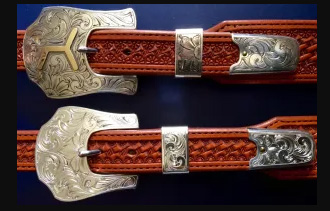
“It was the best thing that ever happened to me in saddlemaking by far. We didn’t have to worry about customers. We didn’t have to worry about ordering materials. Dale sent us everything. It was just show up and go to work.”
Not only did Steve get to work with John, but Dale would check every saddle as he received them and then critique them over the phone with both men. The experience was priceless for Steve. He learned a lot about the lines and balance of saddles from Dale. Steve’s carving was also influenced. Steve had learned the Sheridan style of tooling at King’s and Matt had showed him the Arizona style. Dale used a California style, which Steve eventually morphed into his own style.
Steve returned to making saddles in his own shop. Occasionally, he made a pilgrimage to TCAA member Chuck Stormes’ shop for advice. In 2002, Steve married Cathy.
In 2013, High River was hit by a “thousand year” flood. The water in Steve’s shop reached to just below the motor cases on his sewing machines. The Masons were out of their house for eight months, as it had to be reclaimed due to the mold. They moved out to Cathy’s family’s farm. A borrowed utility trailer became the saddle shop. Friends and customers chipped in to raise money for both Steve and another local saddlemaker, Stan Groff, who was also flooded out.
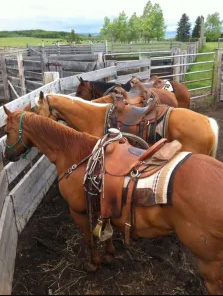
Also in 2013, Steve was awarded the Traditional Cowboy Arts Association Fellowship. This brought visits to all of the saddlemakers in the TCAA. The coaching in their shops was invaluable.
Although the Mason’s live in town, they own a quarter section of land outside of town that they run cattle on. Forty to fifty yearlings are purchased in the spring and sold in the fall. Steve also day works on some local ranches, which allows him to keep his hand in cowboying a little.
“You have to spend some time in the saddle to know what a saddle has to do.”
The time spent with fellow cowboys is also good for business. Most of Steve Mason Saddlery’s business comes from local working cowboys, so it doesn’t hurt for them to see his equipment being used on the job.
“Matt Eberle told me that if you work for cowboys, you’ll never be out of business.”
The style of saddles ordered has changed in Steve’s business. When he started, the demand was mainly for slick forks like Wades. Today, most of his saddles are swell forks. The primary swell is derived from a Lewis Roper style and is called a Dry Gulch. Olin Young styles are also popular. This works well for his customers who ride for a living, but like to compete in team roping on the weekends. Steve also builds a few saddles for horsemen who compete in the cow horse events like John Swales.
All of Steve’s saddles have a similar ground seat, no matter what they are used for. The focus is on comfort for the rider. His cow horse saddles have cantles that are a little shorter, wider and laid back a little more than the ones in his working cowboy saddles. The cow horse swells are derived from a Buster Welch tree and were tweaked by Glenn Christman, Steve’s tree maker. They call this configuration a Swales Tree. All of the trees are covered by one layer of heavier rawhide, which Glenn makes himself.
Steve can do both a metal strainer seat and an all-leather ground seat. They are shaped identically. He feels that the tin seats are a little lighter and have a little less material. He cuts his own metal strainers out.
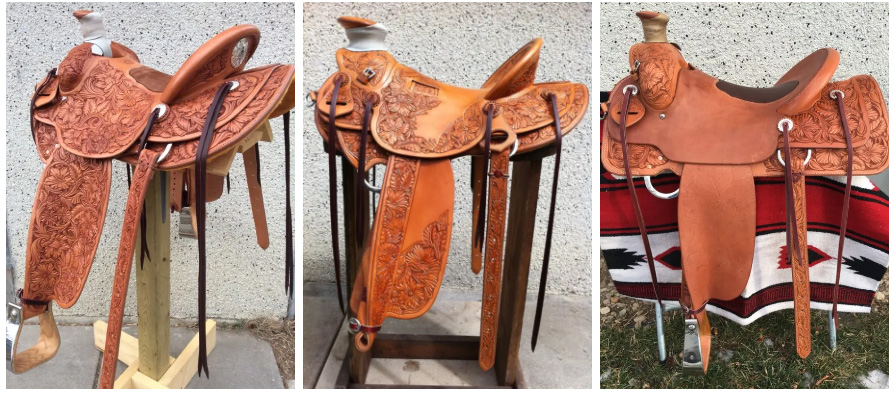
His most popular seat is an inlaid padded seat. Steve never does a full padded seat. Most of his saddles are built with a flat plate rigging, with a few in-skirt riggings thrown in. Although Steve has done a lot of both geometric stamped saddles, as well as floral carved ones, currently the demand seems to be for rough outs. His base price is $5500.
Steve also does his own silver work and credits Jeremiah Watt for helping him with this. This trim gives his saddles an even more personal touch. Steve tries out some of his ideas first on earrings, which are a profitable gift item as well. Other than that, Steve focuses on saddles because that keeps him pretty busy. As a result of this, he has little walk in traffic. He likes the quiet because he can get more done.
“My wife says there’s a reason why I work by myself,” jokes Steve.
At 51, Steve tries to find time to fly fish to relax. He can get out and enjoy the stillness of this open country. Steve still gets a little time in the shop though because he makes his own fishing poles.
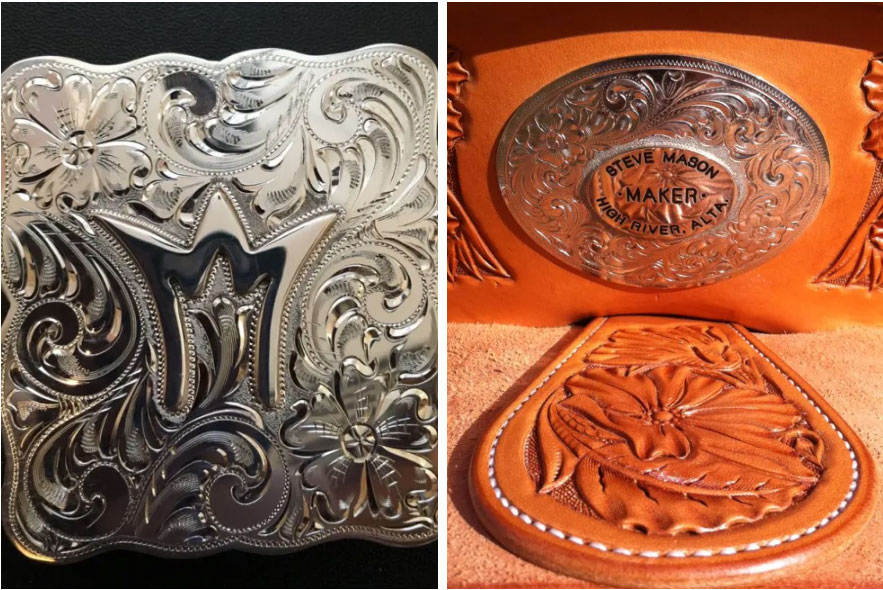
To find out more about Steve Mason Saddlery, go to stevemasonsaddles.com or call 403-615-4616.
This article originally appeared on Shop Talk Magazine and is published here with permission.
There are more interesting articles in our section on Tack & Farm.
































